Upgrading my new HP 14-bp060sa
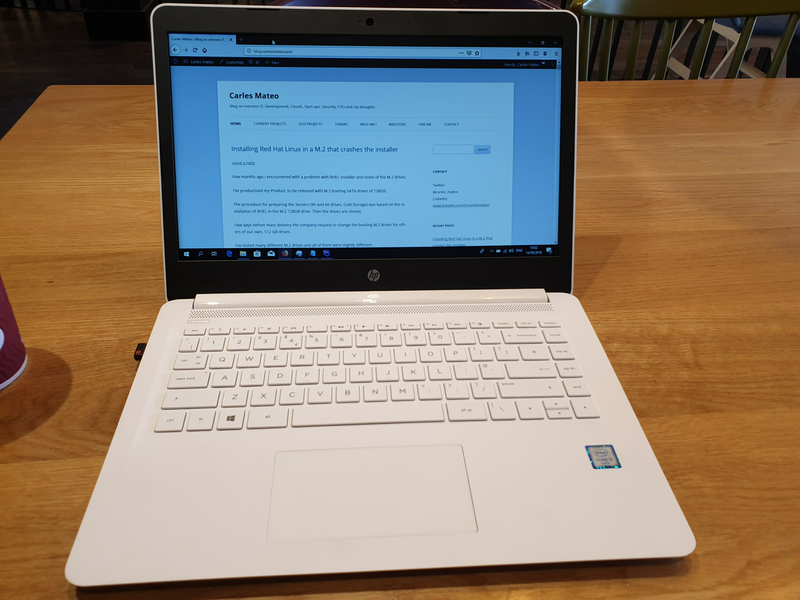
As the company I was working for, Sanmina, has decided to move all the Software Development to Colorado, US, and closing the offices in Bishopstown, Cork, Ireland I found myself with the need to get a new laptop. At work I was using two Dell laptops, one very powerful and heavy equipped with an Intel Xeon processor and 32 GB of RAM. The other a lightweight one that I updated to 32 GB of RAM.
I had an accident around 8 months ago, that got my spine damaged, and so I cannot carry much weight.
My personal laptops at home, in Ireland are a 15″ with 16 GB of RAM, too heavy, and an Acer 11,6″ with 8GB of RAM and SSD (I upgraded it), but unfortunately the screen crashed. I still use it through the HDMI port. My main computer is a tower with a Core i7, 64GB of RAM and a Samsung NVMe SSD drive. And few Raspberrys Pi 4 and 3 :)
I was thinking about what ultra-lightweight laptop to buy, but I wanted to buy it in Barcelona, as I wanted a Catalan keyboard (the layout with the broken ç and accents). I tried by Amazon.es but I have problems to have shipped the Catalan keyboard layout laptops to my address in Ireland.
I was trying to find the best laptop for me.
While I was investigating I found out that none of the laptops in the market were convincing me.
The ones in around 1Kg, which was my initial target, were too big, and lack a proper full size HDMI port and Gigabit Ethernet. Honestly, some models get the HDMI or the Ethernet from an USB 3.1, through an adapter, or have mini-HDMI, many lack the Gigabit port, which is very annoying. Also most of the models come with 8GB of RAM only and were impossible to upgrade. I enrolled my best friend in my quest, in the research, and had the same conclusions.
I don’t want to have to carry adapters with me to just plug to a monitor or projector. I don’t even want to carry the power charger. I want a laptop that can work with me for a complete day, a full work session, without needing to recharge.
So while this investigation was going on, I decided to buy a cheap laptop with a good trade off of weight and cost, in order to be able to work on the coffee. I needed it for writing documents in Google Docs, creating microservices architectures, programming in Java and PHP, and writing articles in my blog. I also decided that this would be my only laptop with Windows, as honestly I missed playing Star Craft 2, and my attempts with Wine and Linux did not success.
Not also, for playing games :) , there are tools that are only available for Windows or for Mac Os X and Windows, like: POSTMAN, Kitematic for managing dockers visually, vSphere…
(Please note, as I reviewed the article I realized that POSTMAN is available for Linux too)
Please note: although I use mainly Linux everywhere (Ubuntu, CentOS, and RedHat mainly) and I contribute to Open Source projects, I do have Windows machines.
I created my Start up in 2004, and I still have Windows Servers, physical machines in a Data Center in Barcelona, and I still have VMs and Instances in Public Clouds with Windows Servers. Also I programmed some tools using Visual Studio and Visual Basic .NET, ASP.NET and C#, but when I needed to do this I found more convenient spawn an instance in Amazon or Azure and pay for its use.
When I created my Start up I offered my infrastructure as a way to get funding too, and I offered VMs with VMWare. I found that having my Mail Servers in VMs was much more convenient for Backups, cloning, to scale up, to avoid disruption and for Disaster and Recovery.
I wanted a cheap laptop that will not make feel bad if transporting it in a daily basis gets a hit and breaks, or that if it rains (and this happens more than often in Ireland) and it breaks is not super-hurtful, or even if it gets stolen. Yes, I’m from a big city, like is Barcelona, Catalonia, and thieves are a real problem. I travel, so I want a laptop decent enough that I can take to travel, and for going for a coffee, coding anything, and I feel comfortable enough that if something happens to it is not the end of the world.
Cork is not a big city, so the options were reduced. I found a laptop that meets my needs.
I got a HP s14-bp060sa for 439€.
It is equipped with a Intel® Core™ i3-6006U (2 GHz, 3 MB cache, 2 cores) , a 500GB SATA HDD, and 4 GB of DDR4 RAM.
The information on HP webpage is really scarce, but checking other pages I was able to see that the motherboard has 2 memory banks, accepting a max of 16GB of RAM.
I saw that there was an slot, unclear if supporting NVMe SSD drives, but supporting M.2 SSD for sure.
So I bought in Amazon 2x8GB and a M.2 500GB drive.
Since I was 5 years old I’ve been upgrading and assembling by myself all the computers. And this is something that I want to keep doing. It keeps me sharp, knowing the new ports, CPUs, and motherboard architectures, and keeps me in contact with the Hardware. All my life I’ve thought that specializing Software Engineers and Systems Engineers, like if computers were something separate, is a mistake, so I push myself to stay up to date of the news in all the fields.
I removed the spinning 500 GB SATA HDD, cause it’s slow and it consumes a lot of energy. With the M.2 SSD the battery last forever.
The interesting part is how I cloned the drive from the Spinning HDD to the new M.2.
I did:
- Open the computer (see pics below) and Insert the new drive M.2
- Boot with an USB Linux Rescue distribution (to do that I had to enable Legacy Boot on BIOS and boot with the USB)
- Use lsblk command to identify the HDD drive, it was easy as it was the one with partitions
- dd from if=/dev/sda to of=/dev/sdb with status=progress to see live status and speed (around 70MB/s) and estimated time to complete.
- Please note that the new drive should be bigger or at least have the same number of bytes to avoid problems with the last partition.
- I removed the HDD drive, this reduces the weight of my laptop by 100 grams
- Disable Legacy Boot, and boot the computer. Windows started perfectly :)
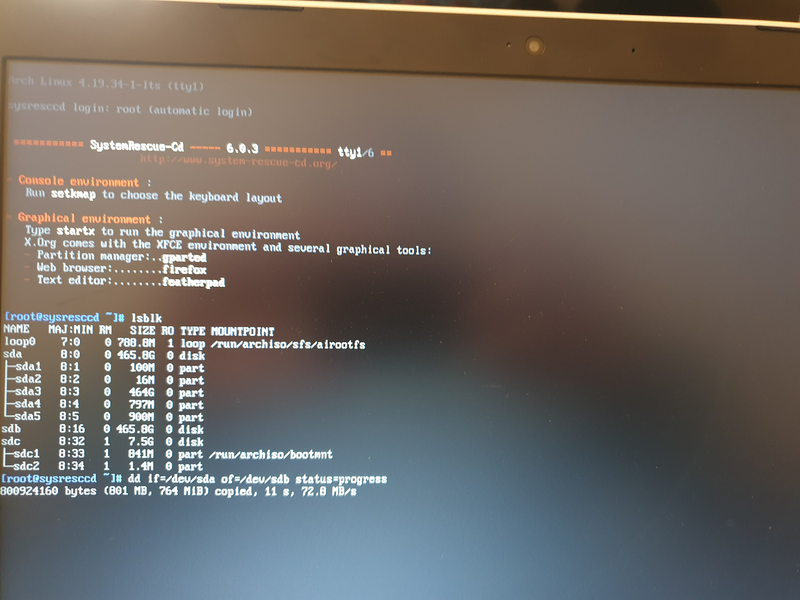
I found so few information about this model, that I wanted to share the pictures with the Community. Here are the pictures of the upgrade process.
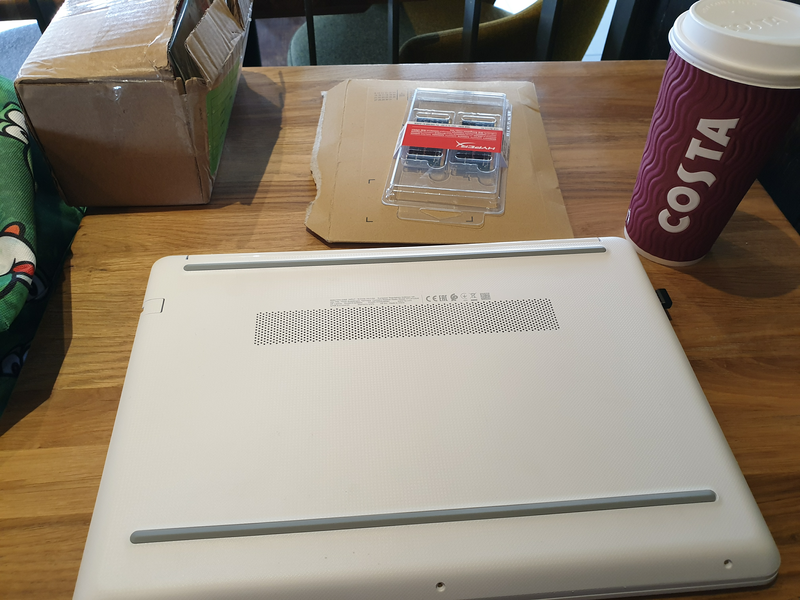
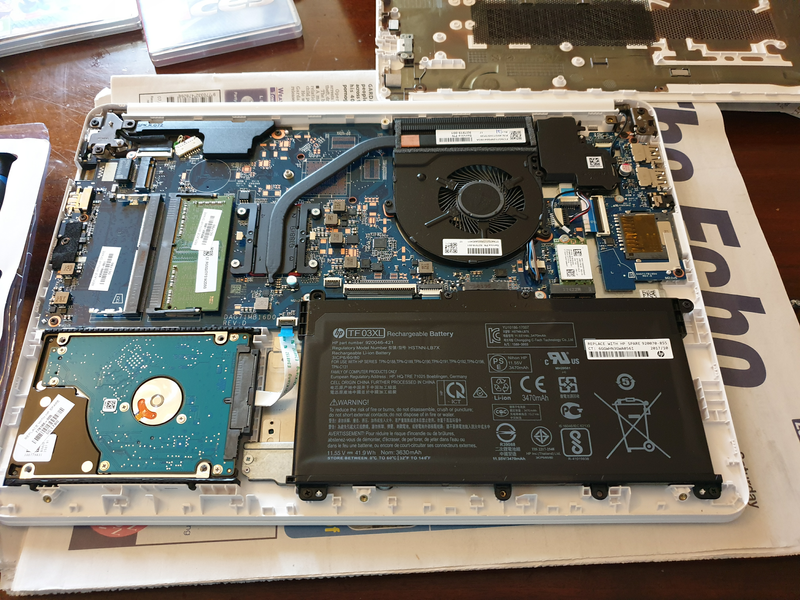
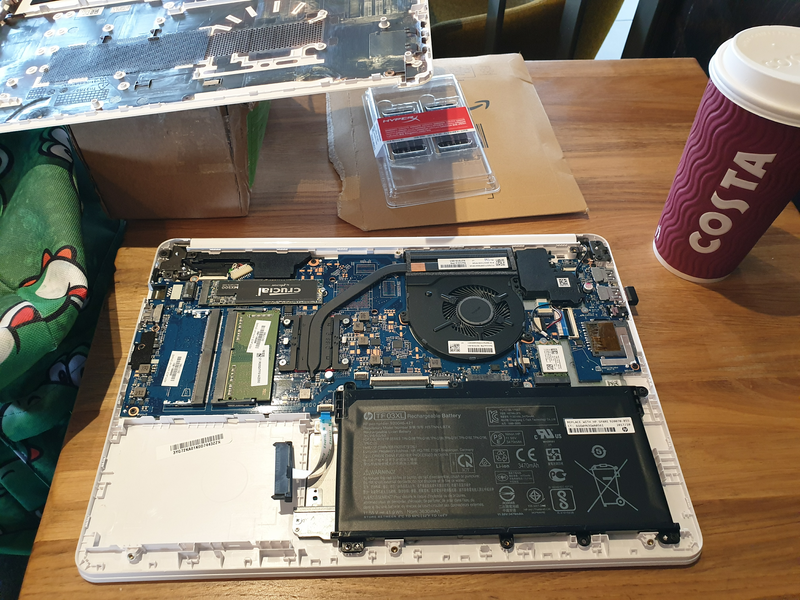
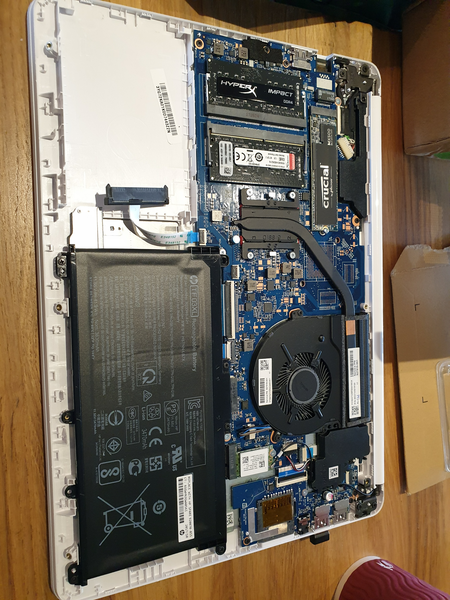
Hi Carles
Thanks for writing this article, I have the same laptop and am going to upgrade mine so this has been really helpful. Is there any chance you can tell me the exact model of the SSD drive that you upgraded to as I don’t want to end up buying the wrong one.
Thanks
Gwin
Hi Gwin,
Thanks for your words. :)
I’m glad to help.
The exact model is:
Crucial CT500MX500SSD4
I bought it in Amazon, its page is:
https://www.amazon.co.uk/gp/product/B077SQ8J1V/ref=ppx_yo_dt_b_asin_title_o00_s01?ie=UTF8&psc=1
However they are not selling it anymore. Neither in amazon.com is available.
The other specs are:
Bytes/Sector: 512
Size: 465.76 GB (500,105,249,280 bytes)
Total Cylinders: 60,801
Total Sectors: 976,768,065
Total Tracks: 15,504,255
Tracks/Cylinder: 255
I searched for one that seems compatible, being in stock in amazon.co.uk
I found this Samsung. I like the Samsung SSD:
MZ-N6E500BW 860 EVO
https://www.samsung.com/us/computing/memory-storage/solid-state-drives/ssd-860-evo-m-2-sata-500gb-mz-n6e500bw/
Checking with Windows System Information, I see that the last partition is the Recovery Partition 900MB (943,718,400 bytes).
And the partition starting offset is: 499,164,119,040 bytes.
That means that the last partition, the windows reinstall/recovery, maybe missing some data. I also think that is probably empty data and that the original drive came like this.
The windows tool for inspecting disks and partitions doesn’t give any error and also when I did dd I did not encounter any error either. So I believe the original drive was like that.
I searched different sites but I was unable to find the number of Sectors of the Samsung drive.
If you want to be 100% sure that all will work you can buy a bigger drive, like 1TB, and after you can create a fourth partition in order to use the extra space.
I’m confident that Windows will work well with any 500 GB or bigger M.2 SATA SSD. I’m not completely sure about the Windows Recovery as I never tried.
Hope this helps.
Cheers
I also want to know if windows 10 operating system can run on m.2 ssd NGFF 2880
I don’t know. Can you provide the manufacturer or the exact model/part number?.
Please I want to truly understand how you cloned the HDD drive to the new M.2 ssd. Bcos I wouldn’t want to loss my files and original windows 10 that came with the system cos I dont have enough to buy a genuine copy of windows 10 and I dont want to install counterfeit copy either.
Thanks
Hi Paschal,
Hope you’re doing great.
This is explained in the article.
You need to boot the Linux and then identify which is your new M.2 and the old hard drive. Assuming the new drive M.2 is /dev/sdb and the spinning drive is /dev/sda the command will be:
dd from if=/dev/sda to of=/dev/sdb status=progress
I recommend you to do a backup first.
If you are not good at Linux, ask somebody to help you, or send the results of the commands here, as a message so I can guide you.
The first to do is:
cat /proc/partitions
To identify what device is the new drive and which one the old.
Take in count that your M.2 must be equal or bigger than the old drive to be cloned.
Cheers
You left the main question unanswered. So is the M.2 connector SATA or NVMe?
The M.2 connector supports only M.2 SATA, so limited to 550 MB/sec. It is not a NVMe port.
It would had been nice to have NVMe support, but this motherboard only supports M.2 Sata.
What Mhz is the Ram that you put in?
The exact model of memory I bought is:
HyperX Impact DDR4 HX424S14IB2K2/16 Memory 2400 MHz CL14 SODIMM 16 GB Kit (2×8 GB), Black
Is available in Amazon.co.uk:
https://www.amazon.co.uk/gp/product/B0722Q3243/
Cheers
Can you upgrade the processor to a quad? Or its not removable from the motherboard?
Thanks
Hi Tamas,
I’ve not unscrewed the ventilator, however I doubt the processor can be replaced.
Normally they’re soldered to the motherboard.
However if you’re looking for a more powerful CPU I recommend you to buy a better laptop.
You can buy one with NVMe socket not just M.2, so the speed of the NVMe Flash drive will be around 3.5 GB/second.
In order to replace the CPU, is not only if it can be removed, you have to look at the specs of what the motherboard supports.
Normally those laptops are embedded with motherboards that do not support a large variety of CPU models.
So my advice is to look for a better laptop, with the CPU you want and NVMe disk.
Cheers.
Carles